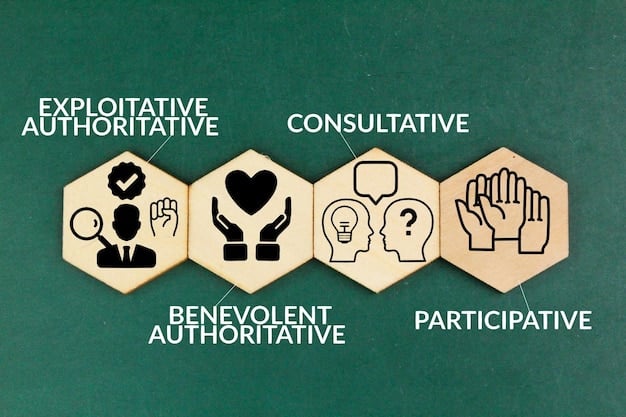Building a Culture of Ethics: Beyond Compliance for US Corporations

Building a culture of ethics in US corporations goes beyond simply complying with regulations; it involves embedding ethical values into the organizational DNA to foster trust, enhance reputation, and drive long-term sustainable value.
Navigating the complex landscape of corporate responsibility requires more than just ticking boxes. Building a culture of ethics that transcends mere compliance is essential for long-term value creation in today’s US corporations. Let’s explore how.
Why Compliance Isn’t Enough: The Limitations of Rules-Based Ethics
While regulatory compliance is a necessary foundation, it often falls short of fostering a truly ethical corporate environment. Rules-based ethics can be perceived as a minimum standard, potentially leading to a “check-the-box” mentality rather than genuine ethical behavior. So what are other factors?
The Illusion of Complete Coverage
Regulations are inherently limited in scope, addressing specific issues and leaving gaps for unethical behavior that technically falls within legal boundaries. Ethical behavior goes beyond what’s required to do what’s right. It requires judgment, empathy and an established moral compass.
The Reactive Nature of Compliance
Compliance is often reactive, responding to past misconduct rather than proactively preventing future ethical lapses. It is a response to the past and often lags behind the evolution of moral standards. A proactive approach looks into the future.
- Focus on adhering to the letter of the law rather than the spirit.
- May stifle innovation and risk-taking due to fear of violating regulations.
- Can create a culture of minimal effort, discouraging employees from going beyond what is required.
Compliance is an important piece of the puzzle but cannot alone establish a robust ethical culture.
The Pillars of an Ethical Corporate Culture
Building a strong ethical culture requires a multi-faceted approach, focusing on leadership commitment, clear ethical guidelines, open communication, and accountability. When implemented properly, those practices should be able to maintain the business’s operation.

Leadership Commitment and Modeling
Ethical behavior starts at the top. Leaders must demonstrate a visible and unwavering commitment to ethical values, setting the tone for the entire organization. Employees are far more likely to follow the example of their leaders than heed their empty words.
Clear Ethical Guidelines and Training
A comprehensive code of ethics, coupled with regular training, provides employees with a clear understanding of expected behavior and resources for navigating ethical dilemmas. These should be part of all onboarding operations.
- Establish a clear and concise code of ethics that reflects the company’s values.
- Provide regular training on ethical decision-making and compliance requirements.
- Offer confidential channels for reporting unethical behavior without fear of retaliation.
Guidelines are a fundamental aspect of ensuring the success of any company.
Fostering Open Communication and Transparency
Creating a culture where employees feel comfortable speaking up about ethical concerns is crucial. This requires establishing safe channels for reporting misconduct and transparent communication about ethical issues. In order to make this happen, safety processes need to be in place.
Encouraging Whistleblowing and Protecting Whistleblowers
Implement a robust whistleblowing policy that protects employees who report unethical behavior from retaliation. Incentives can be put in place for employees who are willing to speak up in order to keep the company in check from the inside and outside from third parties.
Open Dialogue on Ethical Dilemmas
Facilitate open discussions about ethical challenges and dilemmas, encouraging employees to share their perspectives and learn from each other. When people communicate it helps get a better understanding of what is happening in the company.
By establishing a transparent system for communication, the flow of information will greatly improved. Leading to a better overall understanding and awareness.
The Role of Accountability and Consequences
Ethical breaches must be addressed swiftly and consistently, with appropriate consequences for those who violate ethical standards. Accountability reinforces the importance of ethical behavior and deters future misconduct. When there is no accountability, there is room for misconduct and negligence.
Fair and Consistent Enforcement
Apply ethical standards fairly and consistently across all levels of the organization, without favoritism or special treatment. When certain behaviors are tolerated and some are not, this will cause an uproar among staff and undermine the values being promoted.
Learning from Mistakes
View ethical lapses as learning opportunities, analyzing the root causes and implementing corrective actions to prevent recurrence. It’s important to note that many companies fail to learn from past mistakes, ultimately leading to future violations.
Ultimately, failure to learn from mistakes leads to an unsustainable business model.

Measuring and Monitoring Ethical Culture
Regularly assess the effectiveness of the ethical culture through surveys, audits, and other feedback mechanisms. Monitoring helps identify areas for improvement and ensures that ethical values are being upheld. A company which constantly monitors itself is aware of all issues and is able to act accordingly.
Employee Surveys and Feedback
Conduct regular surveys to gauge employee perceptions of the ethical climate and identify potential areas of concern. There should also be a way for external stakeholders to reach out and offer feedback as it will help give a better picture of the organization.
Ethical Audits and Risk Assessments
Perform regular ethical audits to assess compliance with ethical standards and identify potential ethical risks. This could even involve bringing in an external compliance team for the purpose of neutrality and objectivity. Internal bias can prevent identifying issues.
- Track key metrics such as employee reporting rates and hotline activity.
- Use data analytics to identify potential hotspots of unethical behavior.
- Benchmark ethical culture against industry peers and best practices.
Audits make sure things are in compliance and up to date.
The Long-Term Value of Ethical Conduct
Building a culture of ethics is not just the right thing to do; it’s also a smart business strategy. Ethical companies enjoy a range of benefits, including enhanced reputation, increased customer loyalty, improved employee engagement, and reduced legal and regulatory risks. Businesses which act ethically have a higher chance to last longer.
Enhanced Reputation and Brand Value
Companies with strong ethical reputations attract and retain customers, investors, and employees, leading to increased brand value. A good reputation is a sign of quality and trustworthiness. The business will also be able to maintain its public image.
Increased Customer Loyalty and Trust
Customers are more likely to do business with companies they trust to act ethically and responsibly. Over time, this creates customer loyalty, leading to repeat business. The more they are able to trust a company, the stronger the relationship that will be established.
- Attract and retain top talent by offering a values-driven work environment.
- Improve employee morale and productivity through a sense of purpose and pride.
- Reduce employee turnover and associated costs.
Trust is a valuable aspect which should be taken into account.
| Key Element | Brief Description |
|---|---|
| 🏆 Leadership Commitment | Leaders visibly support ethical values. |
| 🗣️ Open Communication | Encourage employees to report concerns. |
| ⚖️ Accountability | Address unethical behaviors fairly. |
| 📈 Monitoring | Regular audits and feedback mechanisms. |
Frequently Asked Questions (FAQ)
▼
Compliance involves adhering to laws and regulations, while ethics encompasses moral principles and values that guide behavior beyond legal requirements. Ethics often involves “doing what is right” even if contrary to what is legal.
▼
Leaders can promote ethics by modeling ethical behavior, communicating ethical expectations, and creating a culture where ethical concerns can be raised without fear of retaliation, while taking appropriate legal action if need be.
▼
Open communication ensures that ethical concerns are reported and addressed promptly, preventing minor issues from escalating into major crises. Open communication also means people are able to express opinions and give feedback.
▼
Effectiveness can be measured through employee surveys, ethical audits, and monitoring of reporting rates and hotline activity. You can also gather information about the current legal status of operations using online tools.
▼
Long-term benefits include enhanced reputation, increased customer loyalty, improved employee engagement, reduced legal risks, and stronger financial performance. You can also avoid being on the front page of a publication for ethical misconduct.
Conclusion
In conclusion, building a culture of ethics that goes beyond compliance is not just a matter of adhering to regulations, but a strategic imperative for US corporations seeking to create lasting value, foster trust, and ensure sustainable success. By prioritizing ethical values, promoting open communication, and holding individuals accountable, organizations can cultivate a culture where ethical behavior is not only expected but embraced.





